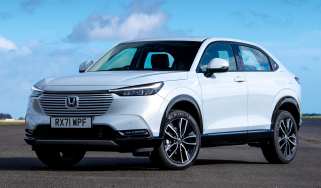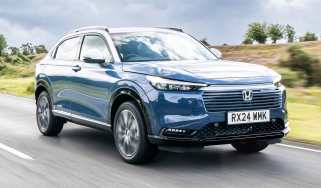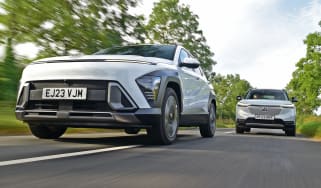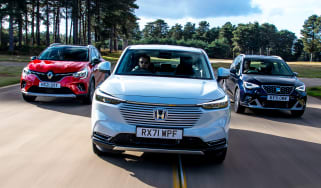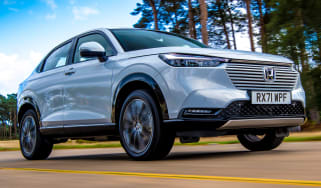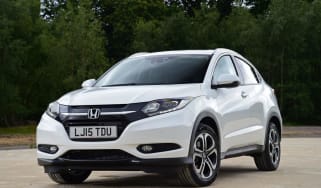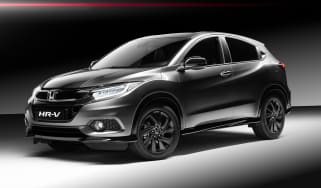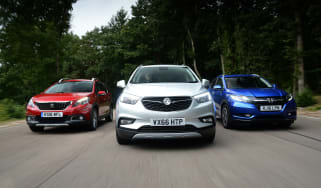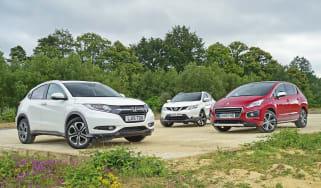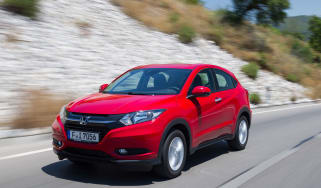Honda HR-V review
There’s plenty to like about the Honda HR-V, but it’s expensive to buy and is eclipsed by the very best in class

Our opinion on the Honda HR-V
The Honda HR-V is a reasonably practical option for buyers wanting a compact SUV that delivers great fuel economy and useful interior space. Its family car credentials are boosted further by an extensive list of standard safety kit and decent on-board tech, while the HR-V isn’t too bad to look at, either.
The catch is that the HR-V is more expensive to buy compared with its closest rivals (listed at the bottom of this review), and has a relatively small boot for the class. Ultimately, it performs the basics well, but doesn’t do enough to outshine the best in a highly competitive section of the market.
| Key specs | |
| Fuel type | Hybrid |
| Body style | Small SUV |
| Powertrain | 1.5-litre 4cyl petrol, plus 1x e-motor, front-wheel drive |
| Safety | 4-star (Euro NCAP, 2022) |
| Warranty | 3yrs/90,000 miles |
About the Honda HR-V
The Honda HR-V is now in its third generation, although you might struggle to remember the last version of this Japanese crossover. Yes, the old model was smart enough, with useful practicality and generous standard kit, but it suffered from a level of anonymity that never really allowed it to become a big hit with buyers.
It was arguably a missed opportunity by Honda, after the quirky first-gen HR-V (launched in 1998) had shown the way for blending 4x4 looks with hatchback style and lower running costs.
Fast forward some 20-plus years, and competition in the compact SUV sector is pretty fierce, with an array of stylish, practical models offering a range of power options – from regular petrol and diesel engines, to the latest full-hybrid and plug-in hybrid technology.
Used - available now
Honda has got the basics right with its latest HR-V: the exterior looks subtly stylish, while a peek inside highlights a simple and well executed cabin design, with good build quality and a pleasing material fit and finish.
Elegance, Advance and Advance Style make up the available trim levels, with the entry specification including 18-inch alloy wheels, LED headlights, digital dials, heated front seats and a nine-inch touchscreen with a reversing camera.
Honda expects the Advance trim to account for 60 per cent of HR-V sales – attracting buyers with extra standard kit such as an automatic tailgate, dual-zone climate control and a heated steering wheel. Top-of-the-range Advance Style models add a contrast roof colour, LED active cornering lights, an upgraded audio system and a wireless smartphone charging function.
Buyers won’t have to spend any time wrangling over what power option to go for, because the HR-V is offered solely with a 129bhp 1.5 i-MMD (Intelligent Multi-Mode Drive) full hybrid set-up, and all models are front-wheel drive only.
Performance & driving experience
| Pros |
|
| Cons |
|
Honda has a reputation for doing things its own way and, while other manufacturers have looked towards plug-in power to deliver lower emissions and help reduce running costs, the innovative Japanese firm has chosen to go with a self-charging hybrid set-up for the HR-V.
Badged e:HEV, the hybrid system uses a 1.5-litre i-MMD petrol engine that acts as a generator to charge the two electric motors, with regenerative-braking tech helping to recharge the battery. Producing a maximum 129bhp, it’s the sole available power option for the HR-V, and is coupled with an e-CVT transmission.
Honda does love giving its engines fancy names, with the i-MMD moniker meaning the HR-V has something called Intelligent Multi-Mode Drive. While not related to any self-driving technology, the i-MMD system will automatically switch between electric, hybrid and petrol engine power, depending on the type of driving you’re doing, in order to provide the best performance and efficiency.
Performance, 0-60mph acceleration and top speed
The HR-V's petrol/hybrid set-up produces a total power output of 129bhp and 253Nm of torque. Honda claims the entry-level Elegance model is capable of 0-62mph in 10.6s, with the Advance and Advance Style versions adding an extra 0.1 seconds to the sprint time. Top speed for all third-generation HR-Vs is 106mph, if you can find somewhere to legally drive that fast.
Renault quotes the same 0-62mph time for the Renault Captur E-Tech Hybrid that rivals the Honda, although during our own testing, we felt that the Captur was keener off the line than the HR-V.
Town driving, visibility and parking
We found driving in town traffic pretty smooth, with the throttle easy to control in electric mode, although the HR-V isn’t quite so serene when you’re pushing on. Accelerate hard and the engine takes a moment to pick up and direct its power to the front wheels, while the typical drone of the e-CVT transmission spoils the levels of refinement. It’s a shame because the HR-V rides well over speed bumps and potholes without too much suspension noise.
B-road driving and handling
Family buyers probably won’t be exploring the limits of the HR-V’s handling, although anyone wishing to make swifter progress will find it’s all very settled and assured through the corners thanks, in part, to Honda working its engineering magic. The firm has increased torsional rigidity by 15 per cent over the previous model, which helps give the HR-V a sportier feel than some of its rivals – especially the Hyundai Kona. The Honda has pleasingly accurate steering and plenty of grip, enabling you to confidently carry a bit of speed through the corners on twisty country roads.
We do find the ‘Road Departure Mitigation’ system to be a bit annoying at times, because it can occasionally nudge the wheel even though you aren’t near the white lines, which is a bit unnerving at speed. It can be switched off, but you have to remember to do so every time you restart the car. It can also be a distraction to do so while driving, because you have to dive into a sub-menu in the driver’s instrument cluster using the fiddly buttons and thumbwheel on the left-hand steering wheel spoke.
Motorway driving and long-distance comfort
Getting up to motorway speeds can be a noisy affair in the HR-V, because the engine is quite boomy when stretched. The revs can also remain high for a reasonable period after you lift off the accelerator once up to speed, as the system tries to keep the battery topped up with charge. Even when the engine has calmed down, there’s a general background hum of road noise (especially over rougher surfaces) and a little wind noise around its upright windscreen and chunky door mirrors.
It does feel very stable at motorway cruising speed, and the brakes provide plenty of stopping power should you need to scrub off some speed when approaching traffic. Again, the ‘Road Departure Mitigation’ system can be intrusive if you forget to indicate when returning to the inside lane after overtaking slower-moving vehicles.
“Switching the safety-assistance systems off can be a chore if you haven’t done it before starting every journey, and it’s potentially unsafe to do so while driving. So I leave it all on, and try to ignore the continual small interventions. It’s a shame, because without them the HR-V is a rather engaging machine to drive.” - Chris Rosamond, Current affairs editor, who ran a Honda HR-V for six months as part of a long-term test.
| Model | Power | 0-60mph | Top speed |
| 1.5 eHEV Elegance | 129bhp | 10.6s | 106mph |
MPG & running costs
| Pros |
|
| Cons |
|
Buyers after low running costs may be drawn to the strong economy figures of plug-in hybrid models – some of which quote more than 200mpg. However, in real-world conditions, you would need to ensure the battery is always kept topped up, and mainly undertake shorter journeys on electric power to achieve such efficiency. The self-charging hybrid set-up used by the HR-V means there is no need for plugging in.
The combination of the 1.5-litre petrol engine and two electric motors provides a WLTP-rated combined economy of 52.3mpg. Our own test of the HR-V took in lots of less-efficient motorway driving, but with an average of 55.1mpg, we still managed to beat Honda’s claimed maximum comfortably. In comparison, its Renault Captur E-Tech Hybrid rival returned 54.3mpg, while the SEAT Arona (with a standard 1.0-litre turbocharged petrol engine) managed 43.5mpg. We’re confident that the HR-V will easily exceed 60mpg on shorter in-town journeys where it can run on battery power much more often.
With a starting price of around £31,000, and CO2 emissions of 122g/km putting it in a Benefit-in-Kind (BiK) tax bracket of 30 per cent, the HR-V won’t be the cheapest company car option. The Renault Captur E-Tech starts at a far more affordable £25,000 in hybrid form, and emits just 108g/km, meaning it is in a lower 27 per cent bracket.
| Model | MPG | CO2 | Insurance group |
| 1.5 eHEV Elegance | 52.3mpg | 122g/km | 32 |
Insurance groups
Arranging insurance cover for the HR-V may prove to be a little more expensive than for some of its close rivals. The HR-V range falls into groups 32 to 33, depending on which trim level you go for. That’s pretty high for a hybrid small SUV, especially when the equivalent Toyota C-HR goes from group 20 to 27.
If you want a more affordable small SUV to insure, try a SEAT Arona, which starts in group 10, or a Ford Puma in group 12.
Tax
The hybrid-only Honda HR-V, like all hybrid cars, no longer qualifies for a small discount compared with traditional petrol or diesel cars when paying yearly vehicle excise duty (VED) road tax. All trim levels cost less than £40,000 when new and avoid the luxury car tax surcharge, but just be careful on the highest Advance Style Plus trim level because adding two-tone metallic paint and a different alloy wheel design will push the price above this limit.
Unfortunately, the higher emissions of the HR-V compared with other hybrid small SUVs mean that it is a more costly company car than the likes of the Dacia Duster, Hyundai Kona, and Toyota C-HR. The HR-V is in the 30 per cent tax bracket, whereas both the Kona and C-HR are in the 27 per cent bracket.
There isn’t a company-car friendly plug-in hybrid version (as there is with the C-HR), but you can consider the Honda e:Ny1 as an all-electric alternative similar to the Hyundai Kona Electric, if you really want to reduce your tax bill.
Depreciation
The HR-V’s decent residual values should reassure buyers about the costs of long-term ownership. The entry-level Elegance model is predicted to hold on to a healthy 50 per cent of its original list price over a typical three-year/36,000-mile period of ownership, with the top-of-the-range Advance Style versions retaining 46 per cent over the same period.
That’s a little below the Hyundai Kona, which is predicted to retain between 46 to 50 per cent over three years/36,000 miles, but way behind the 60 to 67 per cent that the Dacia Duster is predicted to maintain.
To get an accurate valuation on a specific model check out our free car valuation tool...
Interior, design & technology
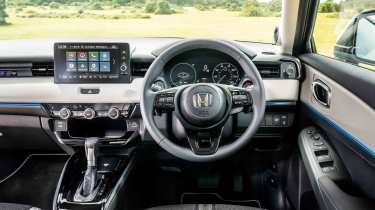
| Pros |
|
| Cons |
|
The previous HR-V model majored on practicality, offering lots of interior space and a huge boot which wouldn’t have looked out of place in the class above. Although still a reasonably versatile family car, the third-generation HR-V is focused on delivering decent efficiency, improved on-board tech and a little extra style in an attempt to stand out in the ultra-competitive small SUV market.
At first glance, the exterior design is certainly eye-catching, with cleaner lines than before and a sloping, coupé-like rear end – shown off particularly well if you go for the Premium Sunlight White Pearl paint option. Standard kit is generous, with all models featuring 18-inch alloy wheels, front and rear parking sensors, LED auto headlights, adaptive cruise control and a 9.0-inch touchscreen with integrated sat-nav, plus Android Auto and Apple CarPlay smartphone connectivity. Buyers also have the opportunity to personalise their HR-V by selecting one of two design packs (Sport or Patina bronze), with each offering different exterior trim options.
Interior and dashboard design
The interior is impressive, with a high level of perceived quality, and a design that, while you wouldn’t call it minimalist, is certainly simple, smart, and well organised. We would advise you to have a good look around a few HR-Vs at your local dealer, because some might find the sombre colour scheme of the Elegance and Advance trims less appealing to live with than the more colourful Advance Style and Advance Style Plus trims.
We approve of the fact that Honda has seen sense to keep physical controls for frequently used features, such as the climate control, which has a set of chunky dials to look after the fan speed and the separate temperature controls of the driver and front passenger zones. They’re even easier to use than the toggles in the Hyundai Kona and Toyota C-HR, and far less distracting than the touchscreen-only controls of the Ford Puma.
The HR-V gets a digital instrument cluster that can be configured to show lots of information, but it isn’t anywhere near as easy to use as the virtual cockpit in a Skoda Kamiq or Volkswagen T-Roc. Unlike its electric e:Ny1 sibling and bigger Honda CR-V brother, the HR-V has a traditional and reassuringly purposeful gearlever rather than a slightly confusing array of buttons.
Materials and build quality
As we’ve often found with Honda cars, the HR-V feels impeccably well screwed together. All the buttons and switchgear have a consistent and high-quality feel, especially the dials for the climate control that provide a satisfying click when you turn them.
Most surfaces you come into contact with use soft-touch materials, although the top of the dash is made of hard plastic, which is a little unusual in a small SUV with premium pricing.
Infotainment, sat-nav and stereo
In essence, the HR-V’s infotainment system is closely related to the set-up used by the Honda Civic, featuring two displays. It’s a big improvement over the old car’s infotainment, but it isn’t the best system on the market.
The main menu page is arranged on a nine-inch screen with large, colour-coded tile icons for all of the major shortcuts, and there are physical home, back, track skip and volume controls to the side, too. The graphics aren’t quite as sharp as we’d like, nor are its loading times all that quick, putting it at a disadvantage against the improved OpenR Link infotainment system used by the Renault Captur that features Google built-in.
There is a My Honda+ app, which can operate as a digital key, using Geo Fence tech to create an alert if the car leaves a specified area, and locate wherever it is parked.
“While the Advance Style and Advance Style Plus trims aren’t worth the extra cost over our Advance trim pick, the latter does look rather dull inside compared with its pricier trim levels featuring lighter accents that lift an otherwise dark interior.” - Max Adams, Online reviews editor, who tested the Honda HR-V over a week-long loan.
Boot space & practicality
| Pros |
|
| Cons |
|
If you’re a family buyer looking for a small SUV that offers decent boot space, then the HR-V won’t be for you. Many of its rivals, such as the SEAT Arona and Peugeot 2008, provide more luggage room, although that’s not to say that the HR-V is completely lacking in practicality.
While its 335-litre boot is merely adequate, you’ll find Honda’s innovative ‘Magic Seats’ set-up in the rear of the cabin, which means not only will the seat backs fold flat, but the squab can also be pulled up into a vertical position - freeing up lots of useful space and allowing you to transport taller items.
The HR-V features a host of standard kit, including automatic wipers and LED headlights, adaptive cruise control and heated front seats. Honda has also designed a new ventilation system for the HR-V, creating air flow along the side window line to help cool or warm the car without generating a draught.
Dimensions and size
The third-generation HR-V is a touch longer than the previous model, at 4,355mm, which also puts it ahead of the Ford Puma (4,207mm), Renault Captur (4,227mm), Peugeot 2008 (4,300mm) and SEAT Arona (4,154mm). Honda has done a good job of ensuring it doesn’t feel cumbersome from behind the wheel, though.
| Dimensions | |
| Length | 4,355mm |
| Width | 1,790mm 2,028mm (inc. mirrors) |
| Height | 1,582mm |
| Number of seats | 5 |
| Boot space | 319-1,289 litres |
Driving position, seats & space in the front
There’s plenty of space on offer in the HR-V for both the driver and front passenger, and the driving position provides the sort of elevated seating position you’d expect of an SUV.
It is slightly disappointing that no version of the HR-V offers adjustable lumbar support, especially when cheaper alternatives such as the Toyota C-HR provide this as standard. You can’t even get electric adjustment with memory settings, even as an option.
Seats & space in the back
If you’ve drawn the short straw and find yourself in the narrow centre rear seat, things will feel a little cramped, but those in the outer positions should find things pretty comfortable, with plenty of leg and knee room for a 5ft 10in adult to sit behind a similarly sized person up front. There’s even lots of room for anyone with size 10 feet to fit their shoes under the seats ahead of them.
The slightly sloping roofline impacts headroom, because if you sit up straight, your hair will be brushing the headlining. Also, anyone in the middle seat will have to figure out how to clip in the three-point seatbelt, because it is stored in the roof when the seat isn’t being used.
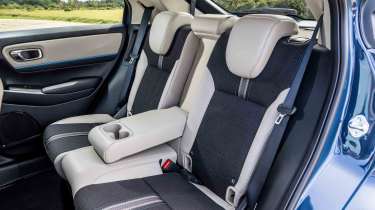
Boot space
It’s a step down in boot size for the latest HR-V, compared with the second-generation model it replaces. But, at 335 litres, the Honda’s load area is still bigger than the Renault Captur’s 326-litre space, although it is trumped by the SEAT Arona’s 400 litres.
The boot lip is slightly stepped, but thanks to the clever Magic Seats folding mechanism, if you fold down the rear seats, you’ll reveal a completely flat load space of 1,305 litres. Not having an incline in the boot floor makes it much easier to pack longer items into a car.
The seats fold in a 60/40 split, which isn’t the most versatile layout, but is typical for the small SUV class.
“Those ‘Magic Seats’ are a really clever feature, and allow for a totally flat floor when the back seats are folded. That’s something we don’t often see in a car these days, including in estate cars where you’d expect maximising the available boot space to be a top priority.” - Max Adams
Reliability & safety
| Pros |
|
| Cons |
|
The third-generation HR-V went through Euro NCAP's battery of crash safety tests in early 2022 and earned a four out of five-star rating for its performance. That’s not unusual in this class, because the Ford Puma and Hyundai Kona also received four-star scores, but it is a little disappointing when alternatives such as the Toyota C-HR get the maximum five-star rating. Euro NCAP penalised the HR-V’s child occupant score due to the seatbelt design slipping off the shoulder of the simulated child test dummy of a 10 year old, and not providing enough head protection for children in the back in the side barrier crash test.
Despite a slightly disappointing score, the HR-V comes with a host of driver-assistance features such as Lane Keeping Assist, Traffic Sign Recognition and a Collision Mitigation Braking function. In true Honda style, it has also attended to some smaller tech details by introducing an improved HD camera and uprating its processing hardware to enhance on-board pedestrian-detection systems.
Honda’s approach to the ownership experience seems to be striking a chord with customers, because the manufacturer finished in a decent 11th place out of 32 manufacturers in the 2024 Driver Power owner satisfaction survey, with buyers praising their car's reliability, quality and running costs above all else.
| Key standard safety features |
|
| Euro NCAP safety ratings |
|
Buying and owning
Our best buy: Honda HR-V 1.5 eHEV Advance
While the entry-level Elegance comes very well equipped, we’d recommend paying a little bit more for the Advance trim. It gives you a number of useful extras, such as an electric tailgate, a heated steering wheel, dual-zone climate control, blind-spot monitoring and adaptive headlights. The HR-V range only has one engine option, so that decision is taken care of for you.
Honda offers a three-year/90,000-mile warranty for the HR-V, and also allows customers to purchase its Extended Guarantee cover for a further one, two or three years at any point after the standard warranty expires, up until the car is eight years old. Prices start from around £450 for a 12-month plan, up to almost £1,000 for three years of additional cover.
Service intervals for the HR-V are every 12 months or 12,500 miles, which is a little more often than some rivals. Customers can choose from individual servicing plans, or they can opt for Honda’s Five Service Plan, which includes five years of servicing for around £800. There is the opportunity to upgrade further to Honda’s full Customer Care Package for an extra £400 – adding a two-year warranty extension and two further years of roadside assistance (in addition to the standard three-year plan).
Honda HR-V Alternatives
Talented rivals such as the Ford Puma, Peugeot 2008 and Renault Captur are firm favourites with family buyers, while the Volkswagen Group's trio of the SEAT Arona, Skoda Kamiq and Volkswagen T-Cross possess great all-round ability.
The Toyota C-HR is a capable contender – benefiting from an all-new version in 2023 that includes an even more efficient hybrid system, along with a plug-in hybrid alternative. Those with slightly deeper pockets may be tempted by the style and extra space of the MINI Countryman. In this company, we’d avoid the Nissan Juke – we’re not big fans of it and find it difficult to recommend due to its firm ride.
Frequently Asked Questions
The Honda HR-V is a stylish yet reasonably practical compact SUV that delivers great fuel economy thanks to Honda’s hybrid technology. The excellent safety kit and decent on-board tech are added bonuses, however, the HR-V is relatively expensive.






